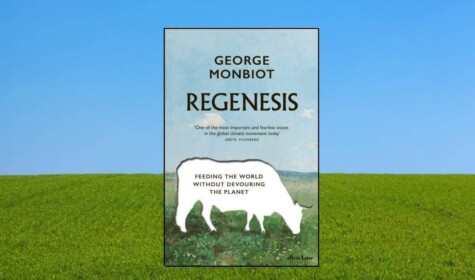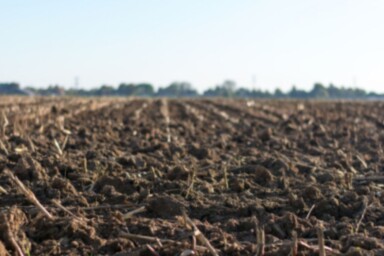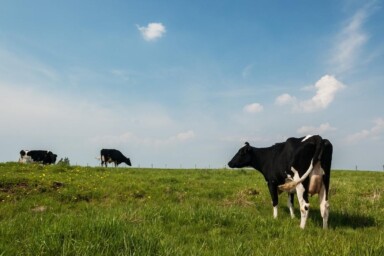George Monbiot’s latest book, Regenesis: Feeding the World Without Devouring the Planet identifies many of the same problems with current food systems that concern the Sustainable Food Trust (SFT). His analysis and proposed solutions, however, differ significantly from ours. Our Policy and Research Team consider some of the key issues.
Monbiot deserves our respect because he cares. Clearly, he feels viscerally for the restricted lives and the suffering of intensively farmed animals. He loves the natural world, and it pains him to see how we have degraded and destroyed it.
Back in 2006, in his book Heat: How We Can Stop the Planet Burning, Monbiot explained why we needed a 90% reduction in CO2 emissions by 2030. If politicians had heeded his call then, we would be much further down the road towards the renewable energy future we will have to eventually adopt, even if that might now come too late to keep the global temperature rise below 2 degrees Celsius. It wasn’t until 2021, that the UK Government finally set a 78% reduction target by 2035.
And, whatever you feel about rewilding, Monbiot’s 2013 book, Feral: Rewilding the Land, Sea and Human Life, helped to draw attention to the crippling losses to biodiversity that have been taking place on farms, while policymakers slept or looked the other way. As such, the book can arguably take some credit for nature restoration projects now being developed up and down the country.
If he has the same awareness-raising impact with Regenesis, he could also play an important role in stimulating debate around the vital issues of how we produce food, what we eat and how we do both in a sustainable way. Reading the book, however, it’s difficult to avoid the conclusion that his years as a prolific author and columnist have taught him – that uncompromising claims and novel solutions, whether workable or not, sell both newspapers and books.
His analysis of the problems with agriculture today is difficult to fault, but in casting his main futuristic solutions, (industrially generated microbial protein, perennial grains and the ending of all livestock production), in such absolutist terms, he overlooks or downplays multiple issues. His approach risks continuing our dependence on agrochemicals and the fossil fuels from which they are made, moving diets even further towards ultra-processed foods, strengthening the grip of food and farming corporations – which Monbiot rightly dislikes – and destroying long-established grassland ecosystems. In addition, as academics who argue strongly for major reductions in meat and dairy products estimate, an entirely vegan diet, as advocated by Monbiot, would require 25% more arable land than one that includes small amounts of high-quality meat and dairy from the significant proportion of the world’s farmlands that are only suitable for growing grass.
Organic farming
Although Monbiot recognises three main benefits of organic farms – they are “more complex and diverse”, “use fewer antibiotics and pesticides” and return carbon to the soil via manure or plant material – generally speaking, he is not a fan. He says, “In other respects, organic farming can inflict more damage”, characterising it as “all muck and no magic”.
Throughout the book, he is critical of organic production, and the main reason for this is its lower yields and therefore greater land requirements to produce the same quantities of grain and other crops as intensive farming. However, while yields are obviously an important consideration (and increasing these sustainably is an aim for the organic sector), it is not necessarily the case that moving towards an agroecological approach to food production would require more farmland. Dietary change, a reduction in the amount of farmland used to grow bioenergy crops and a shift to livestock production systems which don’t consume large amounts of human-edible arable feeds could all help make space for lower-yielding but more environmentally-friendly farming systems, while still freeing up some land for rewilding or other purposes – as has been shown recently at both an EU and UK level.
The nitrogen issue
Monbiot’s focus on yields colours many of the other criticisms which he levels at organic farming. For instance, he references one study which finds that when measured according to kilos of product, organic farming causes as much nitrogen pollution as conventional farming, as well as another study which finds that organic beef loses twice as much nitrogen as conventional. However, such studies are not fully representative, and when nitrogen losses are measured per hectare – which arguably becomes the more relevant metric if dietary shifts and other changes in behaviour allow for a transition towards agroecology without any need for farmland expansion – organic products generally result in lower levels of nitrogen pollution, as found in the original paper which Monbiot references.
Another important issue here is the question of where nitrogen comes from. Conventional farming systems generally rely upon the addition of new nitrogen from synthetic inputs (i.e. chemical fertilisers), whereas on organic farms, most of the nitrogen is recycled, and in the UK most of it is originally provided by nitrogen-fixing forage legumes (like various types of clover and lucerne). This means that all of the greenhouse gas and ammonia emissions (as well as the spiralling financial costs) associated with the production, transport and application of nitrogen fertilisers is avoided in organic systems. But it’s also an important difference because it means that organic production adds less nitrogen to the environment, at a global level, than conventional production, and therefore causes less pollution overall – an uncited point in one of the papers that Monbiot uses to criticise organic farming. Of course, there is important work to be done in reducing the amount of nitrogen lost at present from organic systems, and this is something the organic sector recognises.
A related issue is that Monbiot makes the assumption that the difference between organic and non-organic farms is the fact that the former get their fertility from manure while the latter get theirs from fertilisers. Sadly, this is partly true of some organic farms in some other countries, most notably the US, where ‘big organic’ influenced the setting of lax standards by the USDA, much to the disquiet of traditional US organic producers. However, if we consider organic cattle and sheep farms, it is clear they produce less, not more, manure than conventional equivalent livestock farms because they have slightly lower stocking densities and they feed their cows less protein, and less intensively overall. While a dairy farmer, organic or non-organic, might be induced to spare a load or two of manure for a local organic horticulturalist to turn into compost, the amounts they might part with would be very small, since spreading the manure back on their own land reduces their need for expensive fertilisers.
Carbon footprints
Monbiot also cites a number of papers which find that organic foods generally have a similar or even worse carbon footprint than those that are conventionally produced, when measured per kilo of product. Again, however, this picture changes when we look at the emissions from organic production on a per hectare basis, and when they are compared in this way, organic foods generally come out better. Of course, for this comparison to be relevant, a major shift in diet and other major changes in production practices and land use need to be achieved, otherwise a shift to lower-yielding forms of agriculture would result in more land being required overall. But this is possible: a recent study by the Food, Farming and Countryside Commission showed that a nationwide transition to agroecology, accompanied by changes to what we eat and an end to biofuels production, would enable the UK to reduce its agricultural emissions by 55-70%.
It’s also worth pointing out that many of the studies into the carbon footprints of conventional versus organic foods, do not take into account carbon sequestration which is generally higher on organic farms. In addition, organic foods also tend to have lower energy use footprints, and in a future where we must wean ourselves off fossil fuels and consume much less energy overall, this is a key difference to keep in mind.
Extensive livestock production
Monbiot’s focus on yields (and therefore land use) as the key metric of sustainability also partly explains why he is opposed to all livestock farming, and to extensive, organic, grazing livestock, in particular. He states, ‘‘There might be no more damaging product than organic pasture-fed beef.”
But one has to wonder why he is so opposed to the production and consumption of organic beef, especially when it is produced off grasslands unsuitable for crop production or cropland that has become degraded through continuous arable production. A 2018 review paper found that producing meat, milk and eggs in this fashion, (i.e. by rearing livestock in high-welfare, pasture-based systems where animals are fed on grass and other human-inedible feeds), often on land unsuitable for crop production, would deliver multiple environmental benefits (including a lower arable land requirement than an entirely vegan scenario). While this approach would produce considerably less animal-sourced food than today, it would still provide the world with 9-23 grams of protein per person per day (20-50% of requirements), as well as 10% of our energy and iron needs, 20% of our calcium and zinc needs and a massive 75% of our vitamin B12 needs. Other studies have also found a superior micronutrient content in grass-fed compared with grain-fed beef, indicating the nutritional importance of even relatively small amounts of these products in our diets.
Livestock and greenhouse gas emissions
Monbiot cites studies that find that the greenhouse gas emissions from organic livestock products are similar or worse than those of conventional equivalents. This is a valid claim only where one looks at global averages or studies which include a wide range of different farming systems where the carbon footprint of beef, for example, can range from less than 10 kg to 700 kg of CO2 equivalent per kilo of meat. Claims of this sort also use GWP100 to calculate the CO2 equivalent of ruminant methane which needs to be assessed separately using GWP* because it breaks down after a decade or so, while CO2 once in the atmosphere can stay there for thousands of years.
Climates, soil types, land topography, indigenous and most appropriate crops and breeds of livestock, access to capital and inputs, cultural traditions and nutritional status of local people, vary so greatly between countries – and even regions within countries – that no single solution is even vaguely appropriate for all situations. If we consider the UK, which is the focus of at least some of Monbiot’s claims, there have actually been very few organic versus conventional beef studies. However, what may possibly be the only detailed study of organic versus conventional beef in the UK found, in contrast to Monbiot’s claims of a higher carbon footprint for organic beef, that it was actually lower, 13.46 kg of CO2-equivalent per kg of meat at the farmgate, compared with 15.028 kg for conventional beef.
Nevertheless, Monbiot can hardly be blamed for highlighting the issue of greenhouse gas emissions, which is a hugely important one and which clearly varies between countries and even between individual farms. We would argue that unlike pasture-based and agroecological systems, intensive food production of any kind is umbilically dependent upon the use of fossil fuels – a sector which emits vast amounts of carbon dioxide, as well as nearly as much of the global methane budget as agriculture. Due to the long-lasting nature of carbon dioxide in the atmosphere (as opposed to methane, which is short-lived), we believe that weaning ourselves off fossil fuels should therefore be a higher priority.
Grazing livestock and biodiversity
Overgrazing is clearly harmful, but reducing the value of livestock to efficiency in terms of land-use or emissions, plays into the hands of the intensive livestock industry and neglects the many benefits which grazing livestock can provide, nutritionally and for biodiversity, as recognised by Natural England and the RSPB. Monbiot himself acknowledges that low intensity grazing can be vital for ecosystem restoration, as demonstrated by the Knepp Estate, (which has recently announced the development of an accompanying regenerative farm), but important biodiversity benefits are also found with more productive extensive grazing. Grazing livestock have the ability to alter the sward structure of grassland (without the need for machinery) and deposit dung which is vital for promoting plant species diversity and maintaining the many species of dung beetles, which provide a wide range of ecosystem services, including underpinning food chains for bats, birds, badgers and other mammals. Rather than being seen as ‘inefficient’ these types of grassland systems could be thought of as providing sustainable quantities of highly nutritious food while conserving rare and endangered plant and animal species.
Lab-made food and corporate power
One of the central ideas described in Chapter 7, entitled ‘Farmfree’, is the adoption of protein derived from bacteria in laboratories to replace all animal-based foods. While he does not believe that lab-grown meat, involving the growth of real animal cells, will ever be financially viable, Monbiot whole-heartedly supports the concept of a protein-rich flour produced by bacteria. His vision, which champions futuristic companies such as Solar Foods, sees this flour (and eventually more sophisticated types of protein) being incorporated into a range of plant-based products to fulfil the world’s protein demand – especially in poorer countries.
This seemingly simple solution would supposedly free up vast tracts of land for rewilding – the main draw for Monbiot – but would also require approximately 11% more electricity in the UK alone. The belief that this increase could easily be met by investing in additional solar and offshore wind farms fails to recognise the severity of the existing challenge of replacing fossil fuels with renewable energy. There could also be negative effects on marine life and migrating birds.
One of the first problems highlighted in Regenesis, is that many of the environmental and social issues associated with food production have largely resulted from increased corporate concentration within the food and farming industry – an issue which also concerns the SFT.
Yet, it is difficult to see how his proposed ‘brave new world’ solutions – especially the transition to edible microbial biomass as a major protein source – wouldn’t increase, instead of decrease, the hold that corporations already have over the food sector. Monbiot seeks to solve this issue by strengthening anti-trust laws to limit market-share and restricting intellectual property (IP) rights to enable open-access to new technologies. These suggestions are valid and should be implemented across the sector, if at all possible, however, they seem to be at odds with the intentions of most of the players already operating in this field. Many of the companies working on microbial proteins, the vast majority of which are actually focussed on producing livestock and fish feed, have already filed patents on their processes. Even small food start-ups often rely on IP rights to protect their products and make their business viable. Monbiot envisages a ‘hybrid system’ in which the concepts of cultured meat are combined with bacterial or plant proteins, citing soy leghemoglobin, the blood-like protein used in the ‘Impossible Burger’ as an example. Yet unsurprisingly, Impossible Foods is unwilling to share such a lucrative discovery – as demonstrated in a recent IP dispute. The immense and largely invisible lobbying power exercised by food businesses, which Monbiot is rightly extremely critical of when it comes to the meat industry, would surely make it almost impossible for governments to implement such laws in the first place.
The other major innovation in food production which Monbiot endorses is a move to cereal, pulse and oilseed production based on perennial plants, which would remain in the ground for a number of years before they need replanting – dramatically different to the current situation where almost all of these plants are annuals which need planting every year. Achieving this could deliver a number of environmental benefits, particularly in relation to soil health, although as Monbiot recognises, weed problems and a continued reliance on herbicides may be an issue with this approach. Perhaps the biggest challenge, though, is the fact that perennial grain yields (with the exception of a strain of perennial rice, which is already being grown commercially) are currently very low. While the leading organisation behind the development of perennial grains claims that these are increasing rapidly, a recent review of the evidence to date argued that progress on yields has actually been slow, with yields in the second and especially third year of production being essentially uneconomic. In short, perennial grains could be a very positive innovation in food production in the future – but they are one with major uncertainties and no immediate solution to the environmental problems associated with continuous arable cropping.
Food, farming and culture
Microbial and other types of lab-made foods may well have a role to play in future food systems and may be inevitable if the global population continues to increase as predicted. But many food safety and quality issues would need to be considered first, and the suggestion of a complete shift in what we perceive as food, in order to accommodate them, ignores so much of the deeper cultural meaning behind food and farming for many people.
To address the changing nature of food culture, Monbiot uses a quote by food writer Michael Pollan – “Don’t eat anything your great-great-great grandmother wouldn’t recognize as food”. In compiling a list of what his grandmother ate and concluding that he would prefer to eat his own diet of muesli, nuts, homemade hummus and crackers, he somewhat misses the point that for the vast majority of people, cheap ultra-processed foods have replaced the whole foods consumed by previous generations, with devastating health impacts. It’s hard to see how enforcing lab food technologies, especially in developing countries, would not favour the rampant ultra-processed food industry at the expense of vulnerable groups and the loss of traditional foods (and biodiversity). Another Michael Pollan quote therefore rings true, “If it came from a plant, eat it; if it was made in a plant, don’t.”
There is also the question of what would happen to farming and rural communities (and in particular, those engaged in livestock production) under the ‘end all livestock production’ scenario Monbiot envisages. He recognises that this would be an “extremely disruptive” change that would require a just transition to ensure that farmers would find better paid work elsewhere – something which “given the dire economics of livestock farming”, he believes “might not be a high bar to jump”.
However, with over 1 billion people engaged in the rearing, processing and sale of livestock worldwide, and more than half of this number reliant on livestock for their livelihoods, characterising the end of all livestock production as something that can be relatively easily managed sounds rather glib. Given the socio-economic importance of livestock in low income countries in particular, (and especially for women), the transition Monbiot envisages carries the risk of achieving the exact opposite of a just transition. And while he is right to point out the enormous harm that intensive livestock farming has caused to many indigenous communities, his claim that the end of all livestock production could allow indigenous people to “reclaim and restore their lands” completely ignores the fact that livestock are key to the livelihoods and identities of many indigenous peoples, especially in dryland regions where crops can fail completely during prolonged droughts – 100-200 million people worldwide are engaged in nomadic pastoralism and transhumance.
In the UK, livestock farming may not be as critical to rural livelihoods as it is in parts of the developing world, but it is still hugely important in many areas. In a recent Guardian article, Monbiot argued that farmers make up only a tiny fraction of England’s rural population. He neglected to point out, however, that in some Welsh counties, over 10% of the population is engaged in agriculture, forestry and fisheries and it’s also the sector with the highest share of Welsh speakers. In Scotland, meanwhile, crofting (where grazing livestock are a key component) is central to Gaelic language and culture, and is carried out by up to 65% of households on the Western Isles, Skye and Shetland.
Rewilding
The UK, like most countries, has lost a vast amount of natural habitat over the last century and it is important that much of this is restored. Where this gives rise to ecotourism opportunities, it could provide an economic alternative to grazing livestock production, in at least some instances – as Monbiot points out, there are various case studies which show higher and more diverse levels of employment following conversion to rewilding. However, rewilding only exists as a few case studies in the UK at present, and it is unclear whether it would provide similar or greater levels of employment when rolled out as the dominant land use across the UK’s uplands as a whole. Rewilding really needs to operate at scale – for ecological reasons, but probably also for commercial reasons (the average size of rewilding sites listed by Rewilding Britain is 1,669 hectares, compared with an average UK farm size of 86 hectares) – and so, it is difficult to see how rewilding and ecotourism could totally replace livestock production in areas of the country dominated by small livestock farms. It is also unclear whether rewilding would offer the same level of ‘hands-on’ land management employment – it may do so in early years following conversion to rewilding, as Monbiot argues, but what about after that? Working the land is absolutely integral to the identity of farmers – it is why they do it – and this needs to be kept front and centre in any discussions around the future of rural communities and the way we manage our land.
Conclusion
George Monbiot begins Regenesis with a section on the vital importance of soil biological and microbial life, something he says he has only just come to understand. This, of course, is the same revelation that was set out almost eighty years ago in The Living Soil, by Lady Eve Balfour, a book that inspired the modern organic farming movement. Despite this common starting point, somewhere along the way, his and the SFT’s analysis diverge significantly.
Getting to the root cause of that divergence is beyond the scope of this review. In summary, though, Monbiot’s position (including his albeit reluctant endorsement of the continuing use of glyphosate – the infamous chemical which has contributed to the corporate control of agriculture – to enable crop production without ploughing) is partly based on his understandable desire to promote production methods that use less energy and make the most productive use of as little land as possible. Yet, many of the solutions he proposes are years, if not decades, away from being possible at scale, and each comes with a number of massive risks and assumptions. Regenesis also overlooks the fact that a shift towards lower yielding but much more environmentally friendly approaches to agriculture is itself associated with lower energy use and does not necessarily mean a larger land and environmental footprint – by changing our diets, taking a different approach to livestock production and using cropland to grow food rather than feed and biofuels, we could achieve a much greater uptake of agroecological and regenerative methods, whilst freeing up some land for nature restoration and massively reducing our impact on the climate.
His antithesis to organic farming inevitably appears linked to his total opposition to livestock production, with most organic farming in the UK, at least, being reliant on the fertility-building ability of grass and clover pastures grazed by ruminants. But just as he is willing to make an exception for glyphosate, here too there is an element of inconsistency. He is happy to endorse organic production when it comes from stock-free holdings producing vegetables and overlooks the fact that 20-30% of the land in any year is not producing food because it is sown to grass, clover and similar crops to build fertility – crops that are mechanically cut and mulched, rather than grazed, something which brings down the overall productivity significantly.
Despite these criticisms, Regenesis is a valuable book. It challenges us to think outside the box, presents at least some of the dilemmas with which it wrestles in an even-handed way and introduces us to a technology we may hear more about in future, whether we like it or not. For the SFT, however, it is too often an overly simplified and unhelpfully polarising contribution to the current debate about how to reshape food systems over the next few decades, in ways that make them environmentally sustainable and helps to produce food that reduces the incidence of diet-related disease, rather than allowing this to increase still further.






